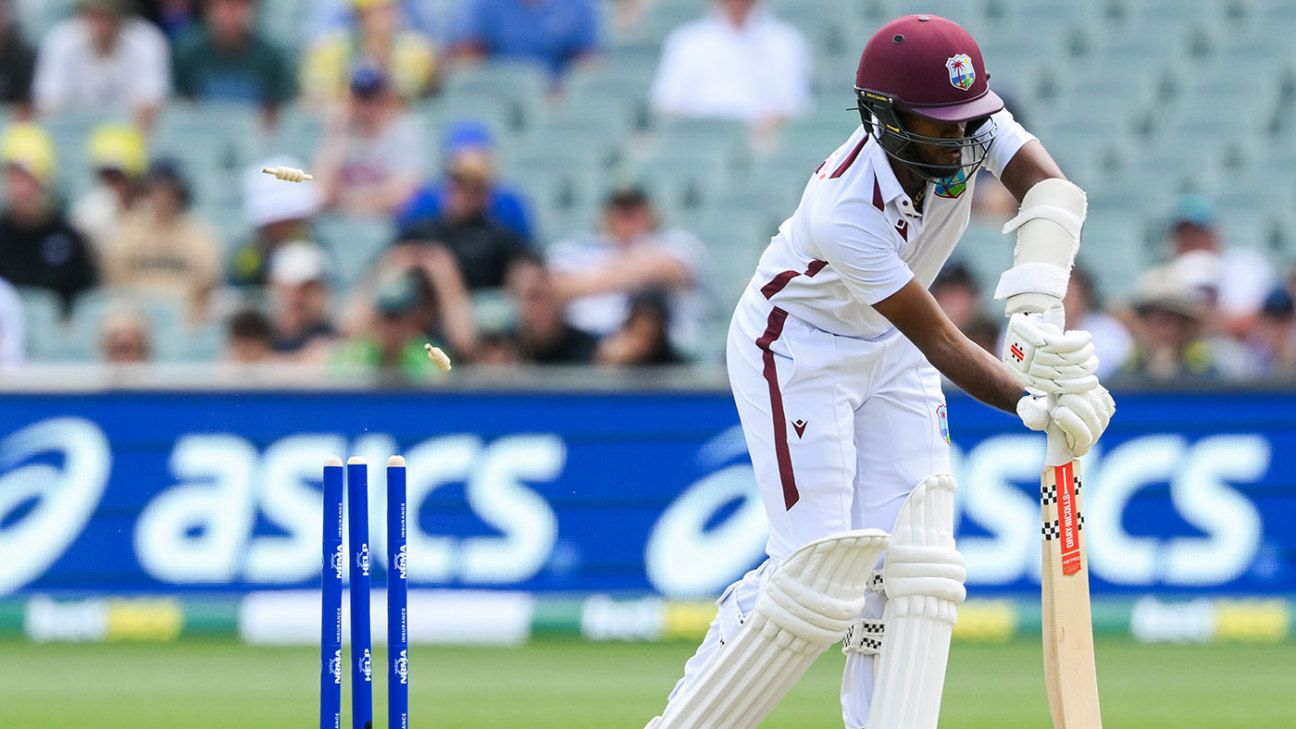Physical Address
304 North Cardinal St.
Dorchester Center, MA 02124
Physical Address
304 North Cardinal St.
Dorchester Center, MA 02124

A spectacular century from Travis Head looms as the difference between the two sides as Australia posted a first-innings lead of 95, which was set to be a lot less after Shamar Joseph took five wickets on debut to put the hosts under extreme pressure. But all that pressure evaporated when Josh Hazlewood ripped through West Indies’ top order again to claim 4 for 2 at one stage and have West Indies reeling at 19 for 4. They lost two more to be six down at stumps still 22 behind Australia.
Despite 26 wickets falling in two days, Coley did not think the pitch was overly challenging for the batters and instead lamented his side’s decision-making despite showing good intent.
“The learning curve has been pretty steep for some of them,” Coley said after play on day two. “But if they were to sit back and some of the feedback has been, it hasn’t been tremendously difficult. It has been testing.
“I think the challenge has pretty much been the consistency of the bowlers, obviously a wealth of experience in that Australian bowling attack, so their ability to stay patient, and there were times our batters played quite well.
“Our intent to score has always been evident but that has to be matched with decision-making here and with a lot more bounce potentially, the ability to leave the ball more consistently has to be part of your repertoire and your approach. Generally, I thought that our intent was pretty good. Our decision-making was questionable on occasions.”
Coley was not critical of his bowler’s decision-making to bowl short to Head earlier in the day despite five of Australia’s top seven being dismissed nicking fuller lengths.
“Originally, the plan to Head was pretty much go short at him upfront, and then plan B was pretty much a comeback into him, shut him down, which we did most of the time,” Coley said. “But by the time he was set, the bowlers jaded. But I thought we stuck to the plans as best as we could, and generally, that worked well.”
Head said he felt like the short-ball barrage got him into his innings having not received much of it during the Pakistan series, where they instead tested his patience on the front foot and wide of off stump with good success.
“I felt like I started well,” Head said. “Obviously, the short pitch stuff, which is what I faced in England, first look at it in Australia where the ball is more consistent, bounces a bit quicker.
“I felt I made really good decisions around that. Swayed out of the way of a few and played a few.
“It sort of got me in the innings a little bit.”
Head was very impressed by the performance of Shamar Joseph who finished with 5 for 94.
“Very good,” Head said. “I think you’ve seen with the quality of our three fast bowlers when they come in, they’re aggressive, they’ve got a fast bouncer, they’re aggressive on the stumps. And he’s got all of that. And he’s young. I thought he was very good. We’ll play him a lot over the next period.”
Coley said Shamar Joseph had delivered exactly what they expected after he had performed so well on the West Indies A tour of South Africa.
“What you see is what you get,” Coley said. “We took him to South Africa earlier. We knew he was inexperienced, but he had pace. He had a natural ability to work to a plan and be consistent with discipline around it. And he’s done that. On the back of that A tour he was fantastic. He got the most wickets on that tour and he showed what he’s capable of in his first Test match.”
Coley said his young players can only get better at Test level with more Test cricket and exposure to high-quality teams like Australia. But he said the lack of fixtures coming up is concerning and will make it harder to keep players committed to red-ball cricket given the amount of franchise opportunities on offer.
“The challenge really is the number of Tests that we do play,” Coley said. “Generally, outside of a Test series against England, we generally play two-Test match series. And then if you look at how our schedule is set up over the next two years, in some instances Test series is six months apart. There’s not a lot in between. So it’s really about us trying to fill the gap in some instances where we can, maybe with other bilateral tours or potentially looking to fit in A team tours that could help to improve that exposure or increase the exposure that the players have.
“Our situation is that financially we aren’t secure enough to be able to offer substantial central contracts and that is always going to be a challenge for us. And what we have tried to do in the last maybe six or 12 months is really have more conversations with the players to be able to work out windows where we can have our best players available. But I believe this is something that is widespread already and will become more of a challenge. But more so for countries who potentially aren’t financially viable and don’t play a lot of Test cricket.”
Alex Malcolm is an associate editor at ESPNcricinfo